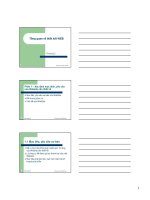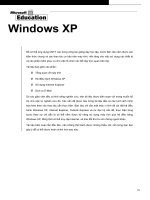Tổng quan Framework Class Library
Bạn đang xem bản rút gọn của tài liệu. Xem và tải ngay bản đầy đủ của tài liệu tại đây (113.6 KB, 11 trang )
147
Chapter 4
CHAPTER 4
Framework Class Library
Overview
In Chapter 3, we focused on some of the key aspects of the .NET Frame-
work and how to leverage them from C#. However, access to these capabili-
ties isn’t limited to C#.
Almost all the capabilities of the .NET Framework are exposed via a set of
managed types known as the .NET Framework Class Library (FCL).
Because these types are CLS-compliant, they are accessible from almost any
.NET language. FCL types are grouped logically by namespace and are
exported from a set of assemblies (DLLs) that are part of the .NET platform.
In order to work effectively in C#on the .NET platform, it is important to
understand the general capabilities in the predefined class library. However,
the library is far too large to cover completely in this book, as it encom-
passes approximately 3,540 types grouped into 124 namespaces and
exported from 38 different assemblies.
Instead, in this chapter, we give an overview of the entire FCL (broken down
by logical area) and provide references to relevant types and namespaces so
you can explore their details in the .NET Framework SDK on your own.
Useful tools for exploring the FCL include the .NET Framework SDK docu-
mentation, the WinCV.exe class browser, and the ILDasm.exe disassembler
(see Chapter 5).
Core Types
The core types are contained in the
System
namespace. This namespace is
the heart of the FCL and contains classes, interfaces, and attributes that all
other types depend on. The root of the FCL is the type
Object
, from which
all other .NET types derive. Other fundamental types are
ValueType
(the
base type for structs),
Enum
(the base type for enums),
Convert
(used to con-
vert between base types),
Exception
(the base type for all exceptions), and
,ch04.24590 Page 147 Wednesday, February 13, 2002 5:21 PM
148
|
Chapter 4: Framework Class Library Overview
the boxed versions of the predefined value types. Interfaces used through-
out the FCL—such as
ICloneable
,
IComparable
,
IFormattable
, and
IConvertible
—are defined here (see “Strings” in Chapter 3). Extended types
such as
DateTime
,
TimeSpan
, and
DBNull
are also available. Other classes
include support for delegates (see “Delegates” in Chapter 2), basic math
operations (see “Math” in Chapter 3), attributes (see “Attributes” in
Chapter 2), and exception handling (see “try Statements and Exceptions” in
Chapter 2).
For more information, see the
System
namespace.
Text
The FCL provides rich support for text. Important types include a
String
class for handling immutable strings, a
StringBuilder
class that provides
string-handling operations with support for locale-aware comparison opera-
tions and multiple string-encoding formats (such as ASCII, Unicode, UTF-7,
and UTF-8), and a set of classes that provide regular expression support (see
“Regular Expressions” in Chapter 3).
For more information, see the following namespaces:
System.Text
System.Text.RegularExpressions
An important type in other namespaces is
System.String
.
Collections
The FCL provides a set of general-purpose data structures such as
Array
,
ArrayList
,
Hashtable
,
Queue
,
Stack
,
BitArray
, and more. Standardized design
patterns using common base types and public interfaces allow consistent
handling of collections throughout the FCL for both predefined and user-
defined collection types (see “Collections” in Chapter 3).
For more information, see the following namespaces:
System.Collections
System.Collections.Specialized
An important related type in another namespace is
System.Array
.
Streams and I/O
The FCL provides good support for accessing the standard input, output,
and error streams. Classes are also provided for performing binary and text
,ch04.24590 Page 148 Wednesday, February 13, 2002 5:21 PM
Security
|
149
file I/O, registering for notification of filesystem events, and accessing a
secure user-specific storage area known as Isolated Storage.
For more information, see the following namespaces:
System.IO
System.IO.IsolatedStorage
An important related type in another namespace is
System.Console
.
Networking
The FCL provides a layered set of classes for communicating over the net-
work using different levels of abstraction, including raw socket access; TCP,
UDP, and HTTP protocol support; a high-level, request/response mecha-
nism based on URIs and streams; and pluggable protocol handlers (see
“Networking” in Chapter 3).
For more information, see the following namespaces:
System.Net
System.Net.Sockets
An important related type in another namespace is
System.IO.Stream
.
Threading
The FCL provides rich support for building multithreaded applications,
including thread and thread pool management; thread-synchronization
mechanisms such as monitors, mutexes, events, reader/writer locks, etc.;
and access to such underlying platform features as I/O completion ports and
system timers (see “Threading” in Chapter 3).
For more information, see the following namespaces:
System.Threading
System.Timers
Important related types in other namespaces include
System.Thread
and
System.ThreadStaticAttribute
.
Security
The FCL provides classes for manipulating all elements of the .NET run-
time’s Code Access Security model, including security policies, security prin-
cipals, permission sets, and evidence. These classes also support
cryptographic algorithms such as DES, 3DES, RC2, RSA, DSig, MD5,
SHA1, and Base64 encoding for stream transformations.
,ch04.24590 Page 149 Wednesday, February 13, 2002 5:21 PM
150
|
Chapter 4: Framework Class Library Overview
For more information, see the following namespaces:
System.Security
System.Security.Cryptography
System.Security.Cryptography.X509Certificates
System.Security.Cryptography.Xml
System.Security.Permissions
System.Security.Policy
System.Security.Principal
Reflection and Metadata
The .NET runtime depends heavily on the existence of metadata and the
ability to inspect and manipulate it dynamically. The FCL exposes this via a
set of abstract classes that mirror the significant elements of an application
(assemblies, modules, types, and members) and provide support for creat-
ing instances of FCL types and new types on the fly (see “Reflection” in
Chapter 3).
For more information, see the following namespaces:
System.Reflection
System.Reflection.Emit
Important related types in other namespaces include
System.Type
,
System.
Activator
and
System.AppDomain
.
Assemblies
The FCL provides attributes that tag the metadata on an assembly with
information such as target OS and processor, assembly version, and other
information. The FCL also provides classes to manipulate assemblies, mod-
ules, and assembly strong names.
For more information, see the following namespace:
System.Reflection
Serialization
The FCL includes support for serializing arbitrary object graphs to and from
a stream. This serialization can store and transmit complex data structures
via files or the network. The default serializers provide binary and XML-
based formatting but can be extended with user-defined formatters.
For more information, see the following namespaces:
System.Runtime.Serialization
,ch04.24590 Page 150 Wednesday, February 13, 2002 5:21 PM
Web Services
|
151
System.Runtime.Serialization.Formatters
System.Runtime.Serialization.Formatters.Soap
System.Runtime.Serialization.Formatters.Binary
Important related types in other namespaces include
System.Non-
SerializedAttribute
and
System.SerializableAttribute
.
Remoting
Remoting is the cornerstone of a distributed application, and the FCL pro-
vides excellent support for making and receiving remote method calls. Calls
may be synchronous or asynchronous; support request/response or one-way
modes; can be delivered over multiple transports (such as TCP, HTTP, and
SMTP); and can be serialized in multiple formats (such as SOAP and
binary). The remoting infrastructure supports multiple activation models,
lease-based object lifetimes, distributed object identity, object marshaling by
reference and by value, and message interception. These types can be
extended with user-defined channels, serializers, proxies, and call context.
For more information, see the following namespaces:
System.Runtime.Remoting
System.Runtime.Remoting.Activation
System.Runtime.Remoting.Channels
System.Runtime.Remoting.Channels.Http
System.Runtime.Remoting.Channels.Tcp
System.Runtime.Remoting.Contexts
System.Runtime.Remoting.Lifetime
System.Runtime.Remoting.Messaging
System.Runtime.Remoting.Metadata
System.Runtime.Remoting.MetadataServices
System.Runtime.Remoting.Proxies
System.Runtime.Remoting.Services
Important related types in other namespaces include
System.AppDomain
,
System.ContextBoundObject
,
System.ContextStaticAttribute
, and
System.
MarshalByRefObject
.
Web Services
Logically, web services are simply an instance of remoting. In reality, the
FCL support for web services is considered part of ASP.NET and is largely
separate from the CLR remoting infrastructure. Classes and attributes exist
for describing and publishing web services, discovering which web services
are exposed at a particular endpoint (URI), and invoking a web service
method.
,ch04.24590 Page 151 Wednesday, February 13, 2002 5:21 PM








